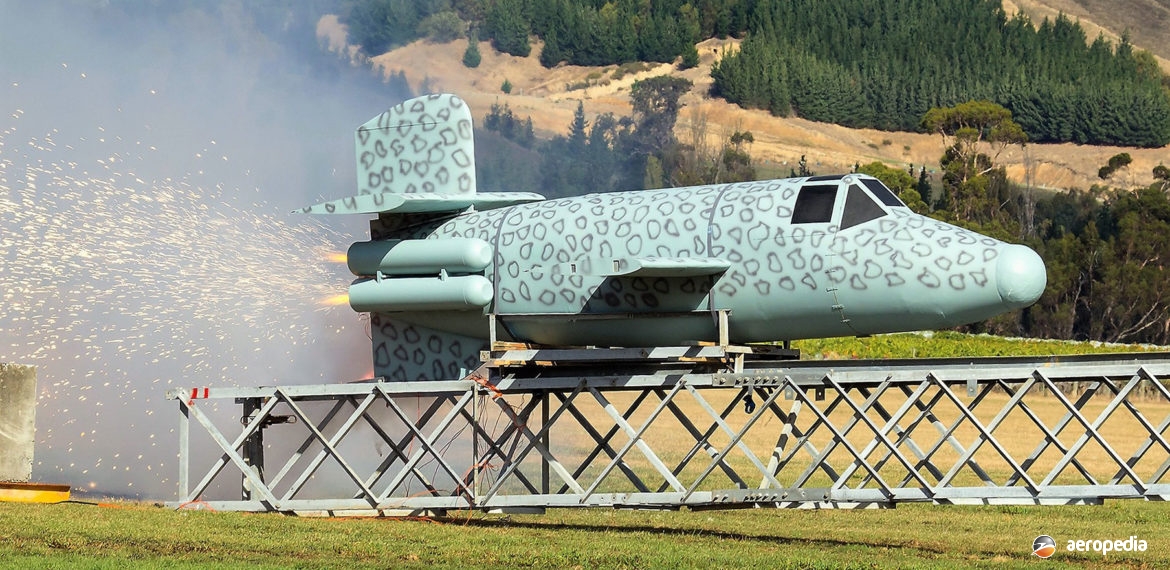Photograph:
Bachem BA 349A Natter replica at Omaka, NZ in April 2013 (Steven Veigel)
Country of origin:
Germany
Description:
Single-seat target-defence interceptor
Power Plant:
One 3,740 lbst Walter HWK 109-509A bi-fuel rocket in main chamber and 660 lb thrust from auxiliary chamber used for cruising flight; four jettisonable Schmidding rockets of 1,100 lb thrust each for one minute for take-off
Specifications:
- Wingspan: 3.6 m (11 ft 9½ in)
- Length: 6 m (19 ft 8 in)
- Wing area: 3.6 m² (38.75 sq ft)
- Max speed at 4,999 m (16,400 ft): 901 km/h (560 mph)
- Initial rate of climb: 10,912 m (35,800 ft/min)
- Endurance under power: 2 mins
- Loaded weight at take-off: 2,330 kg (4,920 lb)
- Weight after jettison of booster rockets: 1,770 kg (3,903 lb)
- Weight of fuel: 880 kg (1,940 lb)
- Weight after firing rocket battery: 740 kg (1,632 lb)
History:
The Bachem BA 349A Natter (Adder) was designed as an inexpensive, semi-expendable, rocket-powered interceptor to deal with the waves of Allied bombers bombing Germany day and night late in World War II. It was designed and built by Bachem Werke GmbH in August 1944, being known with the Company as Project BP-20A. Due to the stage the war had reached it was to be a simple aircraft, workmanship and material quality being sacrificed to achieve the goal of an aircraft able to launch unguided rockets at high-flying bombers. Apart from the fuel tanks and the mainspar in the wing, non-essential materials were used, the wings, tail and fuselage being of wood construction. The rocket projectiles were installed in the nose, the pilot being protected by armoured bulkheads and a bullet proof windscreen.
The engine was behind the pilot, tanks for the fuel comprising T-stoff (hydrogen peroxide and water) and C-stoff (hydrazine hydrate and methyl alcohol) being in the rear of the fuselage. This engine was similar to that fitted to the Messerschmitt Me 163 rocket fighter. Because of the short endurance of the engine it was necessary for the aircraft to be attached to three near-vertical rails 24 m (80 ft) in length, four jettisonable solid-fuel booster rockets being attached to the rear fuselage to provide initial acceleration before the main engine could take over.
Armament was 33 R4M 55 mm folding-fin rockets, or 24 Foehn 73 mm spin-stabilised rockets. An armament of two 30 mm Rheinmetall-Borsig Mk 108 cannon with 30 rounds per gun was considered at one stage. The rockets were fired with a ripple-effect with a brief interval between each to prevent collisions or interference as they were fired.
Detailed work on the aircraft began in August 1944 at a small facility requisitioned at Waldsee in the Black Forest in the State of Baden-Wurttemberg. Within three months of initial design work a number of aircraft were available for testing, the first with a ballasted weight of 1,700 kg (3,748 lb) being towed to a height of 5,486 m (18,000 ft) by a Heinkel He 111 and flown as a glider at speeds from 201 km/h to 684 km/h (125 mph to 425 mph). After a further 10 glider tests a piloted aircraft test was made, the pilot Lothar Siebert losing his life. Further manned tests were successfully completed and, by April 1945, 36 had been completed for service.
Plans were then put in place for Natters to be launched as enemy bombers approached, the aircraft being controlled from the ground by radio/radar link until the machine was near the bombers when the pilot would take over control, jettison the nose cap, and launch the missiles. The pilot was then to eject from the cockpit, the fuselage with the rocket motor then descending by parachute to be used again. Ten were set up near Kircheim on Teck in Baden-Wurttemberg to await incoming bombers but American ground forces overran the area before they could be placed in operational service.
Only one example of the Natter survives, this being held by the US National Air and Space Museum in Washington DC. However, a number of replicas have been completed around the world, including at the Fantasy of Flight Museum in Florida, USA, and the Deutsches Museum in Munich, Germany.
A replica was completed at Omaka in New Zealand in April 2013 and displayed at the biennial Omaka Airshow in Blenheim but was destroyed as part of the pyrotechnics during the show.

